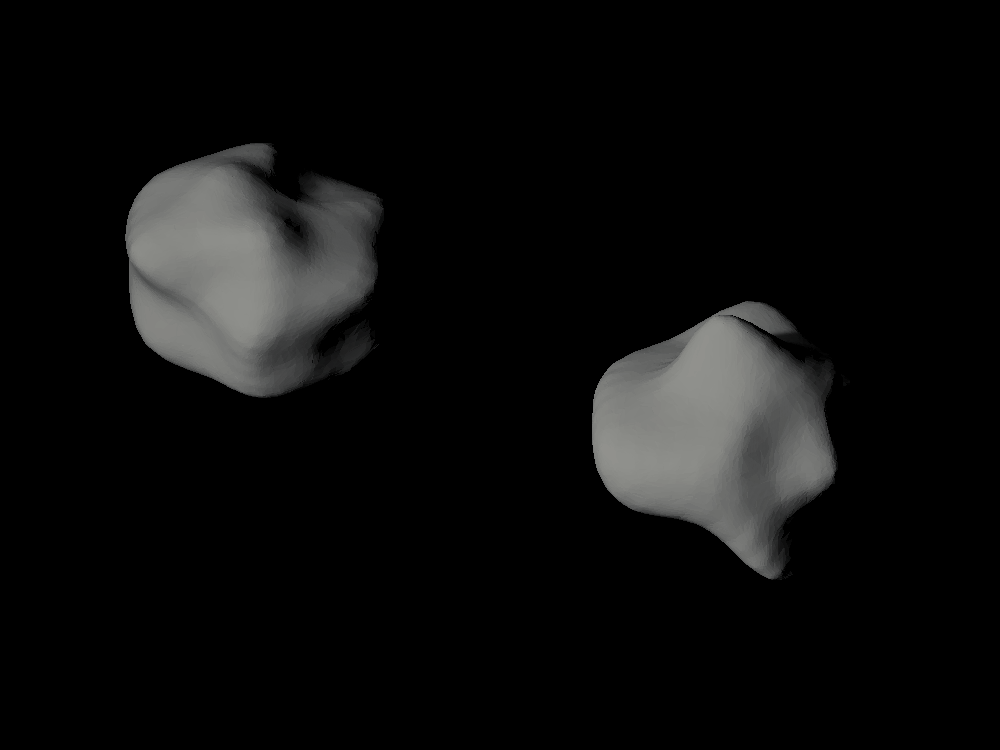
90 Antiope approximate shape scaled one in two million
cults3d
This model was made using the data from Bartczak (2014), I just resize, soften and simplified the models using Windows 3D Builder to share the same scale as other objects. The file's names explained: name_1_x_10_y.stl is 1 : x * 10y. So _1_6_10_7 is 1:600000000 or one in 60 million. 90 Antiope Antiope is the best example of a double asteroid, because it is composed of two bodies of nearly the same size, orbiting each other. There isn't a official definition of a binary object, so Antiope is the name of the bigger body; while the other is just its satellite. The distance between their centers of mass is 170 km, nearly two times their diameters, which means that the minimum distance between them is equal to one diameter. The most similar to a binary object in the Kuiper Belt is the Sila-Nunam system, with the two component of 250 km; the most similar to a double dwarf planet is Pluto and Charon system, with the diameter of Charon a half of that of Pluto; and the most similar to a double planet in the Solar System is the Earth and Moon system, being the Moon's diameter 27% of that of the Earth. Type: Asteroid. Themis family Orbit: Sun. Main Asteroid Belt. Orbital period: 5.6 yr. Composition: Carbonaceous, rubble pile. C type asteroid Density: 1.25 g/cm3. Dimensions: 93.0 km × 87.0 km × 83.6 km. Model scale: 1:1x106 (9cm) 1:2x106 (5cm) S/2000 (90) 1 This component is 2.5% less massive than its companion. It has a noticeably big crater. Type: Binary. Orbit: Antiope. Orbital period: 16 h 30 min 18 s. Composition: Carbonaceous, rubble pile. C type asteroid Density: 1.25 g/cm3. Dimensions: 89.4 km × 82.8 km × 79.6 km. Model scale: 1:1x106 (9cm) 1:2x106 (5cm) References "A new non-convex model of the binary asteroid 90 Antiope obtained with the SAGE modelling technique" MNRAS 443, 1802-1809. Bartczak. 2014. Other astronomical objects Object Scale [1:x] K = 103 (thousand)M = 106 (million)G = 109 (billion) Image Inner Solar System Mercury 20M, 60M, 120M Venus 60M, 120M, 250M Earth 60M, 120M, 250M Luna 10M, 20M, 60M Mars 20M, 60M, 120M Phobos and Deimos 200K, 500K Artificial Salyut 7 40, 48, 80, 160 Near Earth Asteroids Moshup and Squannit 8K, 20K, 40K Ra-Shalom 20K, 40K Castalia 8K, 20K, 40K Bacchus 8K, 20K Bennu 3K, 8K Ryugu 3K, 8K, 20K Geographos 40K, 80K Phaethon 40K, 80K Itokawa 3K, 8K Eros 80K, 200K, 500K Nereus 3K, 8K Mithra 20K, 40K Golevka 8K Toutatis 40K, 80K Main Asteroid Belt Gaspra 200K Annefrank 40K, 80K Braille 20K, 40K Vesta 2M, 4M, 10M Šteins 40K, 80K, 200K Iris 2M, 4M Hebe 1M, 2M, 4M Lutetia 500K, 1M, 2M Julia 1M, 2M, 4M Mathilde 500K, 1M Juno 2M, 4M Ceres 4M, 10M Pallas 4M, 10M Kleopatra 2M, 4M
With this file you will be able to print 90 Antiope approximate shape scaled one in two million with your 3D printer. Click on the button and save the file on your computer to work, edit or customize your design. You can also find more 3D designs for printers on 90 Antiope approximate shape scaled one in two million.
